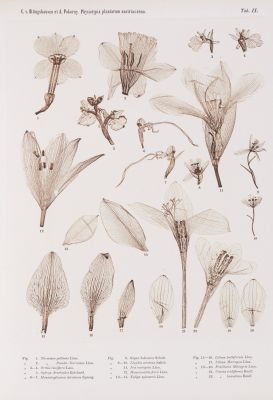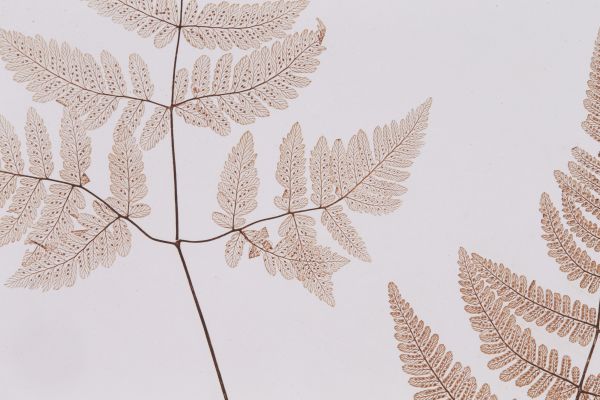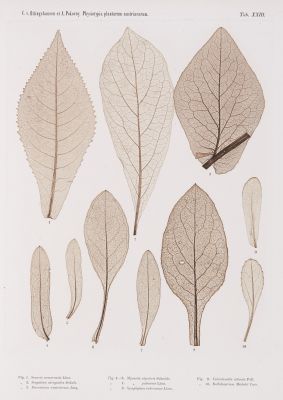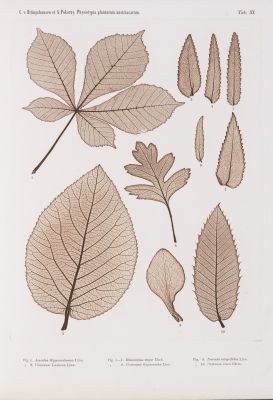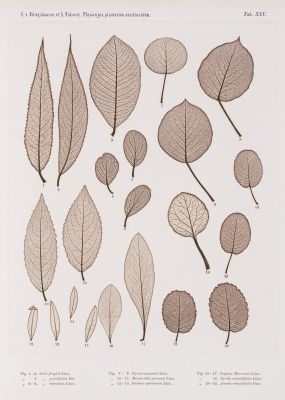
Title
Fig. 1 Stipa Capillata Linn. Fig. 2-3 S. Pennata LinnArtists
Ettingshausen, Constantin (Austrian, 1826-1897)Porknoy, Alois (Austrian, 1826-1886)Publication
Physiotypia Plantarum AustriacarumDate
1856Process
Nature PrintAtelier
Alois AuerImage Size
48 x 29 cm
The present plate was printed under the supervision of Alois Auer, the inventor of the nature printing process, at the Vienna state press. Constantin Freiherr von Ettingshausen, an Austrian botanist, palaeontologist and mineralogist, was a keen supporter of nature printing and published a number of other works using the process. Pokorny worked with von Ettingshausen to improve the quality of nature printing and worked as a teacher and lecturer at various establishments in Vienna, lecturing on phytogeography at the university from 1857-1868.
In Auer’s method, which can only be used with objects with tolerably flat surfaces, the object is placed between a plate of steel and another of lead, both of which are smooth, and polished. They are then drawn through a pair of rollers under considerable pressure. When the plates are separated, it is found that a perfect impression of the object has been made in the leaden plate. This may be used directly as an engraved plate, but only if a very few impressions are wanted, for it is too soft to resist the action of printing presses for practical purposes. For larger numbers of images, a facsimile to be used as the printing plate is made in copper by the electrotype process. In an era before photography and photogravures became commonplace, nature printing provided precise reproductions of three-dimensional physical objects, which were otherwise incredibly time-consuming.
By rolling several colors on the copper printing plate, Auer produced polychrome nature prints. Great astonishment was excited when Auer presented the first proofs of nature printing, in February, 1853, through Anton Ritter von Perger, to the Zoologic-Botanical Society, in Vienna. These prints appeared very true to nature and were printed in their true colors from the gravure plate. Several excellent works on botany were produced at the Government Printing Office by this method. (Eder)
Nature printing allowed for true scientific precision because an exact impression of the plant was used to create the plates. To the modern eye this plate has an almost photographic beauty to it. However, this achievement is almost certainly incidental as von Ettingshausen’s intention was to present a detailed anatomical portrait using the highly exacting method of nature printing.
John Lindley writes "Attempts were long since made to obtain Botanical portraits by printing from the plants themselves, flattened and otherwise prepared for the purpose… The process of the Imperial Printing Office at Vienna, to which the name of Nature-Printing has been happily applied… is a great improvement upon the old method, inasmuch as it represents not only general form with absolute accuracy, but also surface, hairs, veins, and other minutiae of superficial structure by which plants are known irrespective of the hidden details of their hidden organization. Moreover, an exact copy in copper of the part to be represented being employed by the printer, instead of so fragile an object as the plant itself, we obtain the means of multiplying copies to the same extent as in copperplate engraving; and hence the method becomes suitable for purposes of publication." (Preface of ‘The Ferns of Great Britain and Ireland… Edited by John Lindley… Nature-printed by Henry Bradbury’).
References
Eder, Josef M, and Edward Epstean. History of Photography, by Josef Maria Eder. Translated by Edward Epstean. New York: Columbia University Press, 1945.
The Photographic and Fine Art Journal pg. 75, 1

